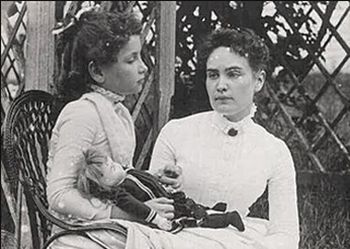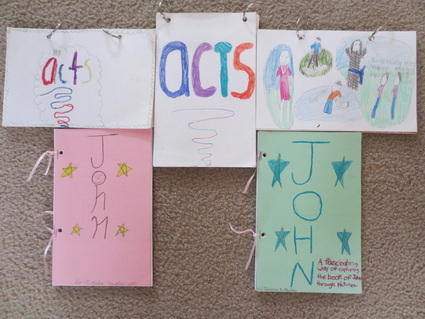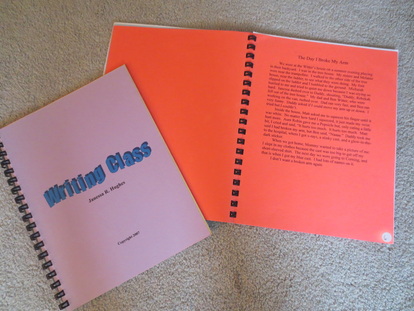Who: Students in elementary or middle school
What: Writing three paragraphs (or longer, if you choose) about related topics
How: For this assignment, tell your students to think in 3’s: 3 friends, 3 presidents, 3 favorite Bible passages, Father/Son/Holy Spirit, 3 characters in a favorite book, 3 favorite books, 3 favorite holidays, 3 inventions of Benjamin Franklin, 3 types of rocks….. Whatever interests your children—fiction or non-fiction—can be the subject of this assignment. They may even want to incorporate whatever they’re currently studying.
This would be a good follow-up assignment to Important Things, giving students additional practice with paragraph writing. Teach (or remind them) about the basic structure of a paragraph (topic sentence, supporting sentences, clincher sentence). Encourage them to focus their content, omitting anything from their paragraph which doesn't support the topic sentence.
Of course, it is not necessary to lock kids into a format. If they already have a "feel" for a paragraph--or if you simply want them to have the freedom to write without restraint--allow them to experiment and be creative. You can always address glaring issues when they revise and edit.
The final copy can be as simple as three paragraphs on a page or as creative as a filmstrip book, which you can find at the portfolder tutorial.
A Sample from Three Different Restaurants:
Applebees
One of my favorite restaurants is Applebees. Their chicken fingers and fries are scrumptious. The kids' meals are hot. I like their activity books with tic-tac-toe and word searches. I like their drinks like lemonade, unsweetened iced tea, which Daddy drinks with a pit pat of sugar, and soda. Sometimes it is quiet. I don't like when people smoke and drink beer at the bar. Applebees is a very delicious restaurant.
A Sample from Three Different Friends:
Kaitlyn
Kaitlyn, a helpful, kind friend, goes to the same church as I do. She is 8 years old, and she has red hair which usually has a headband in it. She rushes so quickly I think she could outrun her dog whose name is Casey. I enjoy playing tag and Jr. Monopoly with her on Tuesday nights.
What "3" did your student choose? Feel free to leave a sample paragraph in the comments or submit one to the Student Showcase.
In The Important Book, Margaret Wise Brown repeats a pattern which illustrates a helpful structure for paragraph writing, particularly for young or reluctant writers.
1. Read The Important Book or click the above book cover to see sample pages.
“The important thing about a spoon is that you eat with it. It’s like a little shovel, you hold it in your hand, you can put it in your mouth, it isn’t flat, it’s hollow, and it spoons things up. But the important thing about a spoon is that you eat with it.
The important thing about a daisy is that it is white. It is yellow in the middle, it has long white petals, and bees sit on it, it has a ticklish smell, it grows in green fields, and there are always lots of daisies. But the important thing about a daisy is that it is white.” 2. Observe the pattern Brown uses. (See #4.)
3. Choose a topic. Brainstorm reasons you think your topic is important. Use this webbing tool to organize your initial thoughts. 4. Imitate Brown's pattern, but make one adjustment. In Brown's paragraphs, her middle sentence--the one that tells why the object is important--is one long string, separated by commas. I recommend writing separate sentences with periods.
A template would look like this: The important thing about _____________________ is ________________________. Detail #1 Detail #2 Detail #3 But the most important thing about _____________________ is ___________________. Write a minimum of three of your very best details. 5. Revise and edit! Are the sentences in logical order? Does one flow well into the next? Are the words spelled correctly? Spruce up the paragraphs to make them your very best.
6. Include your important paragraphs in the comments, or submit them to the Student Showcase.
Student samples: The important thing about God is that He has power over Satan. He is unchangeable and holy. He loves and protects us from Satan. He is majestic and perfect. He wants us to love him and he gave us the Bible so we can read it. He sent his only Son to die for us on a cross and save us from our sins. But the important thing about God is that He has power over Satan. The important thing about Grandmom and Pop pop is that they are fun to be with. They like to cuddle with us when they're watching TV and Eagles' games. Pop pop sometimes sneaks us candy when Grandmom is not looking and he always has long prayers! Grandmom always has a good meal ready when we get there on Thursdays and after we have a fill of TV Grandmom takes us on in a game of Nines. Every time we go there they spoil us and give us more graham cracker pudding than we should have. But the important thing about Grandmom and Pop pop is that they are fun to be with.
"Happiness is a warm puppy."
~ Charles M. Schulz 1. Watch Charlie Brown and his friends sweetly sing metaphors in their song " Happiness Is...." (The song begins at 1:30.)
A metaphor, if you need a refresher, is a comparison between two nouns without using "like" or "as." In this assignment, students compare an abstract term with concrete images.
2. Brainstorm words to transform into metaphors. Here is a start: spring, summer, fall, winter, fear, happiness, disgusted, sad, scared, exciting, soft, rough, sweet, salty, fast, noisy, quiet, any color.... 3. Allow students the pleasure of writing sensory-rich images for their word(s). Help them, if necessary, by encouraging them "to use color, sounds, actions, and sensations of touch and smell in their metaphors" ( Any Child Can Write 76). Some student examples: - Noisy is screaming kids in the street playing with their friends.
- Noisy is lions roaring in the zoo because they are mad about being in a cage.
- Red is a yummy Red Delicious apple being cut up and sliced into a pan, cooked for applesauce, and dumped on a cake.
- Red is an enormous firetruck racing down the street to get to a fire.
- Green is a tree that waves as the wind whistles through its leaves.
- Orange is a juicy fruit that when you take a bite it splashes onto your face.
- Autumn is colorful leaves falling to the ground.
If you like pre-writing sheets, here's one. Idea prompted by Harvey S. Wiener in Any Child Can Write, 75-77.
Norma Simon wrote I Know What I Like, a picture book with a very specific pattern.
The first set goes like this:
I like to make pudding.
I like to make pictures.
I like to make faces.
But I don't like to make my bed or pick up in my room. (I do it anyway.) The rest are like it.
I like to (verb)....
I like to (same verb)....
I like to (same verb)....
But I don't like to (same verb)....
After reading the book together, talk about the pattern: three likes followed by a don't like. (If you can't find a copy of this out-of-print book, you can still easily do the assignment. The prewriting sheet will help you.)
Under Set 1 on the prewriting sheet, write an example together. If you have a student new to writing, the sentences can be simple like Simon's. For students who can do more, encourage longer, more detailed sentences.
Here is one student's example: I like to make fresh chocolate chip cookies (and eat them).
I like to make up funny jokes that make me laugh so hard I cry.
I like to make whoopie pies with aunt Elisabeth because we don't see her very often and she makes great whoopie pies! I like it because sometimes Poppop sticks M & M's in them when Grandmom is not looking because if she is he is in big time trouble!
I don't like to make "awkward scenes" in the grocery store because that turns my mom hot pink and I throw a fit and sooner or later my bottom starts hurting from that spanking! Well, I have never done it, but I also don't want to try.
Invite your children to work on the other three sets.
If appropriate, push your writers beyond their first draft. Revising their writing will polish it, making it shine a little brighter.
Please post an "I like/I don't like" set in the comments.
Do you have reluctant writers in the house? Maybe you can entice them with an easy assignment: an acrostic poem about themselves because, you know, it's pretty easy to write about ourselves.
1. Have them write their names vertically on a sheet of paper. J
A
N
E
S
S
A2. Ask them to write descriptive phrases of themselves for each letter. Janessa's looks like this: Jr is my nickname that my dad gave to me when I was little. It stands for Janessa Renae.
A crazy human being (that can sometimes be annoying)
Never has, never will like going to bed
Eats lots of baked oatmeal because it is very "rumbly to my tumbly"
Sugar is what I like best because it is good to eat but it is not good for you .
Shopping is fun to do with Grandmom because she gets me anything I want .
An actress
3. You have a choice here. You can accept the acrostics "as is," or you can encourage your writers to go beyond the first phrases spilled out on paper, revising some or all of the lines to make them more descriptive. Some kids will be open to toying with their work after setting it aside for a day.
Others might need a little push to revise. For them, you can make specific rules. Let's think of a few possibilities.
- No word may be repeated.
- The acrostic must include at least one strong verb, adjective, and adverb.
- Include alliteration in one line.
A related idea:
Make an acrostic poem for something else you are studying. It could be a time period (Revolutionary War), a person (George Washington), a place (Pennsylvania), anything really.
Hey, Little Ant by Phillip and Hannah Hoose is the perfect book to teach point of view, but this time let's use it to encourage students to write in four modes: persuasive, expository, narrative, and descriptive.
Here are some assignments, which may be paragraph length or longer, that students can complete:
1. Read Hey, Little Ant.
2. Camp on the last page, where the narrator asks the reader whether the kid should step on the ant. Write a persuasive piece, giving your opinion of what the kid should do. Of course, it is important to include convincing (or funny) reasons and/or examples to back up your opinion.
3. Study the picture of the ant on the last page. Describe the ant as he awaits his fate. Use lots of details which include the senses (sight, sound, smell, taste, touch). 4. Write an expository piece. Explain the situation between the boy and the ant OR explain the procedure for killing an ant OR explain the ant's get-away plan. 5. Write a narrative piece. Tell the story of the kid and the ant OR tell the story of a time you encountered an insect. What did you do? (It's okay to embellish it to make it more interesting!)
Those are my ideas. If you think of ones that suit you better, use them instead!
Send me students' finished pieces to inspire other young writers. It would make my day!
Who: Preschool and elementary ages
What: Illustrate and write captions for a Book of the Bible
When: During family devotions
When I had little people to teach about Jesus, I read the Bible with my girls. For the projects shown here, I read a chapter aloud each morning. The girls chose something from the chapter to illustrate, and wrote a caption to summarize their drawing. We accomplished three goals with this simple project: hearing God's Word, practicing drawing skills, and writing brief summaries.
Note: I didn't mandate the cover drawings. One certain someone liberally borrowed her older sisters' ideas, much to their annoyance.
 Pages from a 6th grader's Fashion Chic magazine Who: Any age What: "Publish" a magazine about a topic/theme of the student's choice How:Collect a variety of magazines for your students to browse, or look through the magazine collection at your local library.List the types of pieces included in the magazines.Invite students to brainstorm possible themes for their own magazines (e.g. sports, fashion, animals, adventure, current events, history). The assignment (to be modified to your situation)- Write and revise at least five substantial* pieces: articles, advice column, interview, etc.
- Make at least four miscellaneous pieces: puzzles, advertisements, comic strips, etc.
- Make a cover and a Table of Contents.
- Put it all together in an attractive presentation.
*You can define substantial for your students. Set a deadline. (Remember that too little time may result in rushed products, but too much time may encourage procrastination.) Ask students to write a proposal for you, their publisher. With their best writing, they need to explain their vision for the magazine. Possible content to include:- An explanation of the topic/theme and why they chose it
- A brief overview of the pieces they plan to write
- A brief overview of the extras they will include
- A plan for how they will budget their time to meet the deadline
- An explanation of how they hope their completed magazine will look
As the publisher, you need to approve the proposal or return it for further work.Set aside time each day for researching, planning, writing, revising, and laying out the magazine. To help students stay on target, consider giving them a chart for setting goals and recording completed work. Magazines may be bound in regular binders or taken to an office supply store for coil or spiral binding.Please send me pictures! I want to see the results. : )
Year ago I offered a class in my home. The objective for the students was simple: to write a variety of pieces to include in a coilbound book. The students included a cover, Table of Contents, dedication, and About the Author. Simple but effective. Your students can make their own books, too. Maybe they have ten (or so) pieces scattered on notebook paper. Have them walk through the writing process for each one, moving the pieces from rough to polished. Or maybe you're at a loss for what should go in the book. If that's the case, browse through the ideas in Inspiration. Choose assignments that will interest your students and get them writing. Details to Consider:- Because these are polished pieces, they need titles.
- Typing the pieces will make the books look crisp and finished.
- You will have a sturdier book if you print the text on cardstock.
- Illustrations would add a nice touch.
- I highly recommend the extras: the cover, Table of Contents, dedication, and About the Author.
- Binding is available at office supply stores. It's fast and it's cheap.
Once the books are ready, set them on the coffee table where family and visitors can page through them. Don't be surprised if you find the authors looking through them as well. They'll be that proud!
When I mentored a young history buff this past summer, I asked her to choose a person or event to study. She chose Helen Keller. I brainstormed fun and challenging writing assignments for her, which I now share with you! Use the ideas as stand-alone assignments or in a project. Project Ideas:- Make a blank book with Keller as the subject.
- Display the assignments in a portfolder with various flaps and folds.
- Print each piece on cardstock and compile the collection in a book with coil binding, comb binding, strip binding, or book-style binding, available at office supply stores.
- If you have multiple students completing the assignments, make a book (similar to the previous idea) with chapters. Students can brainstorm creative titles for each section.
Do a KWL chart. Set aside time (one hour?) when you’re doing something with others—playing with friends or sisters, helping Mom in the kitchen—to be deaf, blind, and mute (any or all). Write about your experience. Read about one of Helen’s many temper tantrums. Write about the incident, once from Helen’s point-of-view, once from Annie’s. "Interview" Annie or Helen. What lessons can we learn from Helen’s life? Write a paper with an engaging lead and a satisfying conclusion. What word best describes Helen? Write a paragraph with several examples. Write a poem about Helen and/or Annie. Find some structures here. Write a scene based on the picture below. Be sure to answer who, what, when, where, why, and how. Include the senses.  ~Helen Keller & Annie Sullivan - July, 1888~ Photo courtesy of Wikipedia Write a quote from Keller's autobiography in braille. Your own ideas (I never assume my ideas are the only or best ones. Getting you out of the gate is my goal.)
|








 RSS Feed
RSS Feed